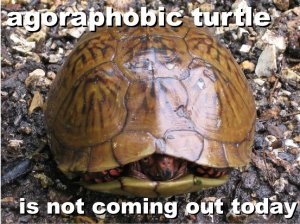Taking Ownership of Public Spaces
Today I went out to get a coffee, just to get myself out of the house for a short while. I’d been doing work around the house all day and was beginning to feel cooped up, and figured that a ten-minute walk to the end of the street and back (and the small amount of social interaction involved in buying a drink) would do me some good. Since I live with an anxiety disorder that often manifests itself as agoraphobia, little trips out into public space are an important thing for me.
Because I suffer from these bouts of agoraphobia (fear of or anxiety regarding open spaces and social situations, often manifesting as an inability to leave the house), I’m a person who is very aware of the divides between private, public, and semi-private spaces. I’m very protective of my own private space, and guarded when entering public spaces. When in public or in others’ private spaces, I am very aware of the etiquette surrounding these spaces and make a conscious effort to be “proper”. It can, therefore, be incredibly difficult for me to deal with anyone who I see as being “improper”.
 There are a lot of people, though, who don’t seem to have an understanding of where it is, and isn’t, polite to do certain things, and on my trip out of the house today I encountered one of these individuals. As I entered the coffee shop and got in line, I could hear someone talking very loudly. Almost yelling, in fact. Their voice filled the entire coffee shop, like an actor projecting to reach the cheap seats at the back of the theatre. I looked around, half expecting to see someone talking on a cell phone, oblivious to their surroundings. We’re all familiar with this particular brand of rude person: instead of stepping outside to get better reception, they yell their half of a one-sided conversation at top volume (often punctuated with a lot of, “sorry, could you repeat that? Bad reception in here”).
There are a lot of people, though, who don’t seem to have an understanding of where it is, and isn’t, polite to do certain things, and on my trip out of the house today I encountered one of these individuals. As I entered the coffee shop and got in line, I could hear someone talking very loudly. Almost yelling, in fact. Their voice filled the entire coffee shop, like an actor projecting to reach the cheap seats at the back of the theatre. I looked around, half expecting to see someone talking on a cell phone, oblivious to their surroundings. We’re all familiar with this particular brand of rude person: instead of stepping outside to get better reception, they yell their half of a one-sided conversation at top volume (often punctuated with a lot of, “sorry, could you repeat that? Bad reception in here”).
What I saw, though, was something that I had never encountered before: a whole new brand of rude human being. Two women, sitting with their small children, and one of the women was reading what appeared to be a bedtime story (something vaguely racist about the difference between Italian and Chinese noodle dishes and kids being turned into pasta via magical accident). At top volume. Their bags, coats, and other belongings were spread out across two tables and spilling onto the floor. One of the kids was running around and not listening to the story. And they were being glared at (and commented on) by almost every customer in the place.
Of course a restaurant is not, strictly speaking, public space. It is owned by someone (in this case, the owner of that particular Tim Horton’s location), and they are free to set their own rules regarding what is accepted and what is not. The fact that no employees seemed to be bothered by this woman’s display made me timid, and I felt like I couldn’t approach them and ask them to be quieter. I simply took my drink “to go”, and left the rudeness behind. Still, a restaurant dining room is only semi-private, with the general public being invited to come and go and to use the space in a variety of ways. Despite it belonging to someone else, I can’t help but think of that Tim Horton’s as “my” Timmies, as I’ve visited it several times a week for over three years now.
As I walked home, iced coffee in hand, I reflected on the fact that these rude customers obviously considered this Timmies “theirs” just as much as I considered it “mine”. They felt entitled to use the space for their loud reading, and to take up multiple tables in an almost full coffee shop, just as they would in their own private space.
This got me to thinking about how we all take ownership of certain public and semi-private spaces. We have “our” neighborhoods, “our” parks, “our” restaurants, and bars, and favourite places to hang out. We feel safe in these places, and the people we share them with form a community, even if we’ve got nothing else in common. We feel personally violated when we hear about a robbery at “our” convenience store, or vandalism at “our” park, or violence in “our” city. We band together to support “our” community theatre, or to restore “our” historical monument. Especially for someone like me, having public spaces that are safe and familiar is very important, because it makes it easier to get myself out of the house and not be such an agoraphobic turtle. But communities are important to us all, because they form one of the foundational elements of a society.
It’s hard to define at what point that sense of ownership goes from being positive and community-building, to being entitled and hurtful. Anything which denies others their enjoyment of a space could probably be considered negative — but even that isn’t a hard-and-fast line. Protests, for example, tend to happen in public space, and are often an impediment to the daily lives of people who use those spaces, but nonviolent protest is a basic human right and can be an agent for incredibly positive change (note that I only say “can be” — there are some protests that cross the line into entitled abuse of space, such as the Occupy Toronto campers who heavily damaged a public green space with their actions … one of those times where I agree with a group in spirit, but not in methodology). Art, too, can blur the lines between building and destroying: a piece of graffiti may be considered vandalism by some, art by others, while a guerrilla theatre performance may be enjoyed by some, but seen as threatening or a nuisance by others. We as artists have to be aware of the multiple lenses through which our work may be viewed, and try to limit the negative, or else we risk alienating our audiences. And yet, not all “great” art is comfortable and friendly. Sometimes alienation is all a part of the message.
Another troubling side to the ownership of public spaces can be seen in this theory of why many mass-murderers are privileged white men. The general idea is that public mass murders are most likely to be committed by those who believe that the public space belongs to them. To quote from the article:
For white male murderers from “nice” families, the fact that they chose public spaces like schools, university campuses, or movie theaters as their targets suggests that they saw these places as legitimately theirs.
The suggestion here is that when we decide that a space is our own, we may begin to lose track of what it is “proper” to do in that space. We may abuse resources, take up too much space, or just talk too loudly, ultimately denying others their enjoyment of what should be shared.
I think that this is one of those situations where a greater awareness of the problem is likely to solve it entirely. If we are all more aware of the people around us, we’re less likely to abuse the public and semi-private spaces that we share. If we all make an effort to ensure that our sense of ownership does not become a sense of entitlement, we’ll build strong communities on the foundation of these shared public spaces.
I kind of wish that I’d said something to the loud-reading woman and her table. A simple, polite, “Could you please keep it down? Others are trying to enjoy the space.” But I’m not very good at approaching strangers, so I just took my coffee and ran away. I sacrificed “my” coffee shop, if only temporarily. And I’m a bit annoyed at myself for that, because my community (and my sense of belonging within it) is important to me.

Leave a comment